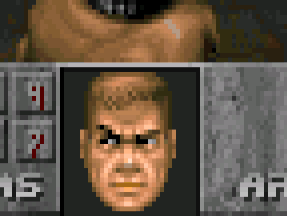Which is completely wrong. Doom when it was designed was specifically created so that the central character would have absolutely no character. Anything invested into the character would come from the mind of the person playing it.
Absolutely incorrect. Doom was designed around the game play with little (no) focus on the story, but still managed to have a character on the box art and on some of the posters. Also, and separate from this discussion, the game actually showed you the main characters ACTUAL FACE at ALL TIMES during ACTUAL GAMEPLAY.
"Look at his face when you keep firing lol".
They went out of their way to make him as generic as possible. Doom Guy was just the "Guy that survived and didn't get massacred when the gates of hell opened and flooded the base."
So generic they gave him a face and expressions in the actual game. On show. At all times (unless you specifically turned it off).
Half-Life 1 had Gordon. Which one up'd this by giving the guy a name. But other than that, again they went out of the way to make him as generic as possible. He doesn't even talk...
So generic they gave him one of the most distinctive character designs in FPS history - a character design that was used in huge amounts of advertising, from "lifesize" cardboard cutouts, to posters, to box art, to concept art that was supposed to help shape the feel of the entire game.
I already talked about him not even talking and the player not seeing his face but this not stopping the effectiveness of a good character design in marketing. I'm not sure why you'd even say
"He doesn't even talk...", like it meant something after I've
specifically talked about how he's been used in very effective marketing
despite the fact he doesn't talk ...
Halo followed in Doom's footsteps. Make the central character as bland and generic as possible, even to the point of not giving him a name. They want the PLAYER to feel as if it is THEM in the game, and not some character created by Bungie.
Someone doesn't understand the difference between gameplay sections and cut-scenes, and even more confusingly, between gameplay and "things used for marketing".
As for Golden Eye, what else are you supposed to do with a 007 game? Bond IS 007.
I'm sure you could argue that he's a generic character with no visual style, character or morality if you wanted. It wouldn't work, just like with Gordon Freeman, but I'm sure you could try.
Doom Guy got the name Doom Guy because there was NO NAME given to him by ID. So fans of the game just gave him the name Doom Guy. Hell, considering the bland armor you could have been playing a Girl. But the lack of obvious in-you-face boobs and most of the gaming population at the time being guys meant he was inferred to be a guy. Although at no time did ID state whether it was even a guy or a girl.
Did you ever actually play Doom?
Apparently not.
http://doom.wikia.com/wiki/File:Normal_face.png
http://www.daveanddi.com/assets/images/Doom-Box.gif
http://www.gamershell.com/screenpop.php?id=226816
The Doom marine is not, and has never been, a woman.
This is Beyond 3D. And we are talking about Doom. Doom!!!! Just ... ggarrhh.
Halo 2 obviously now had a recognizable character because Halo became popular and thus faceless bland armor suit suddenly became an iconic figure.
The character was incredibly simple but obvious and marketable even before Halo 2. As evidenced by the way he was successfully used in the marketing of a multi-million copy selling game. Faceless doesn't have to mean invisible.
Half-Life 2 same story. Gordon was now iconic because the game had gotten to hit status. And even then Gordon is STILL generic and bland.
Not the point, but the point seems to be well and truly lost a this point.
Gordon Freeman has a memorable face and outfit. Even his crowbar is iconic enough to be used in full page adverts.
Far Cry, yes they were tellling a story with a main character where the main character was a prominent part of that story. And even had a little bit of background. I still have no clue who the Far Cry guy is though. Meaning the character itself was still rather bland.
Could you stick him on the box and on posters? Yes. Yes you could, and I know this because they did.
Gears of War, yes, they used him in an advert...successfully.
Yes, like with Halo and Half Life 2.
But as obonicus was stating. For the most part and specifically with regards to Doom Guy and Master Chief. The games made the main characters into popular iconic figures rather than Doom Guy and Master Chief selling the games.
The characters helped sell the games.
Most FPS games still try not to characterize the person that the player is controlling. It helps with immersion. Gives players and opportunity to imagine it is them in the game rather than someone else.
This is gut wrenchingly excruciating.
It's not about what FPS games try to do in game(play). I specifically pointed this out. I already talked about how HL2 doesn't show you Gordon Freeman or let you hear his voice but how the character was used successfully in marketing his game.
I fear this is a distinction far too subtle to be understood at this point.
Either way. You remember Doom Guy, Master Chief and Gordon because of the game. There is absolutely nothing about them that would set them apart from Joe Schmoe member of their particular organization in the games. Although I suppose Master Chief was a Spartan so that made him no different than any other member of a small elite team of soldiers.
If you can't see it, you can't see it.



